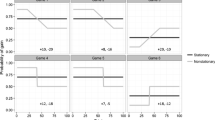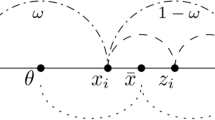Abstract
Research has established that exposure to a combination of diagnostic (i.e., relevant) and nondiagnostic (i.e., irrelevant) information results in predictions that are more regressive than predictions based on diagnostic information (Hackenbrack, 1992; Hoffman and Patton, 1997). This phenomenon has been labeled the dilution effect (e.g., Tetlock and Boettger, 1989) and has been documented when individuals make predictions. This study tests for the dilution effect when small groups make predictions, and examines the effect of using a procedure designed to reduce the dilution effect. Results indicate that group predictions are influenced by nondiagnostic information in the same manner as are individual predictions, and allowing participants to rate the diagnosticity of information prior to making predictions does not reduce the dilution effect.
Similar content being viewed by others
REFERENCES
Accountants International Study Group (1975), Going Concern Problems. Newport Press, New York.
American Institute of Certified Public Accountants (AICPA) (1988), The auditor's consideration of an entity's ability to continue as a going concern, Statement on Auditing Standards No. 59. AICPA, New York.
Arnold, V. and Edwards, D.E. (1993),Going concern evaluation: Factors affecting decisions, The CPA Journal 63 (10): 58-60.
Brown, R. (1965), Social Psychology. Free Press of Glencoe, New York.
Burnstein, E. and Vinokur, A. (1975), What a person thinks upon learning he has chosen differently from others: Nice evidence for the persuasive arguments explanation of choice shifts, Journal of Experimental Social Psychology 11: 412-426.
Carlson, J.A. and Davis, C.M. (1971), Cultural values and the risky-shift:A crosscultural test in Uganda and the United States. Journal of Personality and Social Psychology 20: 392-399.
Cohen, J. (1988), Statistical power analysis for the behavioral sciences. Lawrence Erlbaum Associates Inc., Hillsdale, NJ.
Deutch, M. and Gerard, H.G. (1955), A study of normative and informational social influences upon individual judgment, Journal of Abnormal and Social Psychology 51: 629-636.
Forsyth, D.R. (1990), Decision Making. Group Dynamics (2). Brooks/Cole Publishing Company, Pacific Grove, CA. pp 308-315.
Goethals, G.R. and Zanna, M.P. (1979), The role of social comparison in choice shifts, Journal of Personality and Social Psychology 37: 1469-1476.
Hackenbrack, K. (1992), Implications of seemingly irrelevant evidence in audit judgment, Journal of Accounting Research 30: 126-136.
Hans, V.P. and Doob, A.N. (1976), S. 12 of the Canada Evidence Act and the deliberations of simulated juries, Criminal Law Quarterly 18: 235-253.
Hoffman, V.B. and Patton, J.M. (1997), Accountability, the dilution effect, and conservatisim in auditors' fraud judgments, Journal of Accounting Research 35: 227-237.
International Federation of Accountants (IFAC) (1986), Going concern, International Standard on Auditing No. 23. AICPA, New York.
Kahneman, D. and Tversky, A. (1979), Prospect theory: An analysis of decisions under risk, Econometrica 47: 263-291.
Kaplan, M.F. (1975), Information integration in social judgment: Interaction of judge and informational components, in M.F. Kaplan and S. Schwartz (eds), Human Judgment and Decision Processes, Academic Press, New York. pp 139-171.
Kaplan, M.F. (1984), How do people influence deliberation? A social psychological view, Behavioral Sciences and the Law 2: 1-6.
Kaplan, M.F. (1987), The influencing process in group decision making, in C. Hendrick. (eds), Group Processes, Sage Publications, Newbury Park, CA.
McCauley, C., Teger, A.I. and Kogan, N. (1971), Effect of the pretest in the riskyshift paradigm, Journal of Personality and Social Psychology 20: 379-381.
Moscovici, S. and Zavalloni, M. (1969), The group as a polarizer of attitudes. Journal of Personality and Social Psychology 12: 125-135.
Nisbett, R.E., Zukier, H. and Lemley, R. (1981), The dilution effect: Nondiagnostic information weakens the effect of diagnostic information, Cognitive Psychology 13: 248-277.
Rutledge, R.W. (1993), The effects of group decisions and group-shifts on use of the anchoring and adjustment heuristic. Social Behavior and Personality 21: 215-226.
Rutledge, R.W. and Harrell, A.M. (1994), The impact of responsibility and framing of budgetary information on group-shifts, Behavioral Research in Accounting 6: 92-109.
Schultz, J.J. and Reckers, P.M.J. (1981), The impact of group processing on selected audit disclosure decisions, Journal of Accounting Research 19: 482-501.
Stoner, J.A.F. (1961), A comparison of individual and group decisions involving risk. Unpublished master's thesis. School of Industrial Management, Massachusetts Institute of Technology.
Tetlock, P.E. and Boettger, R. (1989), Accountability: A social magnifier of the dilution effect, Journal of Personality and Social Psychology 57: 388-398.
Zukier, H. (1982), The dilution effect: The role of the correlation and the dispersion of predictor variables in the use of nondiagnostic information, Journal of Personality and Social Psychology 43: 1163-1174.
Zukier, H. and Jennings, D.L. (1983-1984), Nondiagnosticity and typicality effects in prediction, Social Cognition 2: 187-198.
Author information
Authors and Affiliations
Corresponding author
Rights and permissions
About this article
Cite this article
Young, G.R., Price, K.H. & Claybrook, C. Small Group Predictions on an Uncertain Outcome: The Effect of Nondiagnostic Information. Theory and Decision 50, 149–167 (2001). https://doi.org/10.1023/A:1010390527827
Issue Date:
DOI: https://doi.org/10.1023/A:1010390527827




